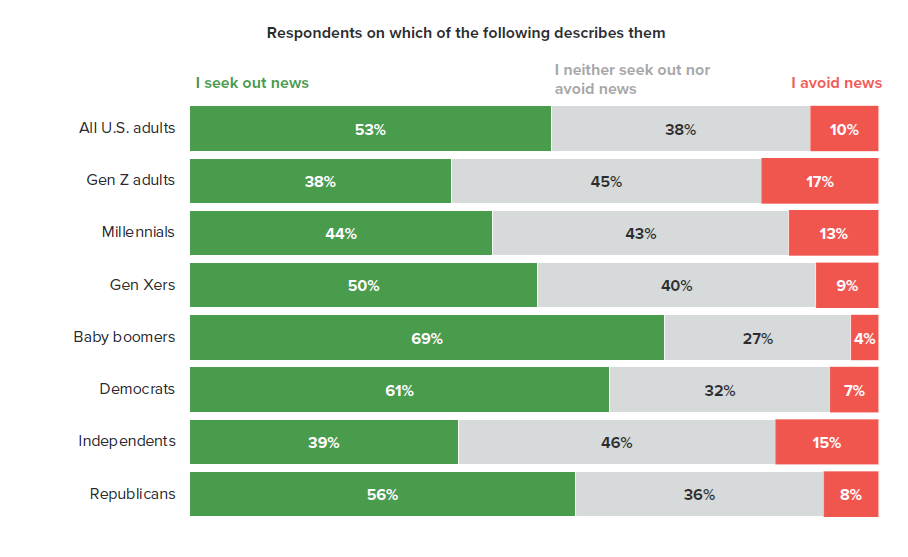By the Numbers: What consumers think about paying for news
Paywalls can be a boon for news outlets and a pain for PR pros — but what does the general public think?

Paywalls seem to be cropping up on every news site, cutting off stories that once would have been freely available to the public. Just this week, CNN announced it will charge users who read an unspecified number of articles $3.99 per month for all access. Reuters announced a similar plan, with its plans starting at $1 per week.
Pay-to-read content can be a double-edged sword for PR professionals. The journalism industry needs steady, reliable income in order to pay journalists and survive. But a paywall will almost definitionally reduce the reach and readability of content — including that which may feature your client. The type of paywall can also affect the repercussions of a paywall: under the CNN and Reuters scheme, any article can be read by the public so long as they aren’t a power user. Under other plans, such as USA Today and regional newspaper owner Gannett, certain articles are marked for subscribers only, restricting readership across the board.
But how does the general public feel about paying for news?
A new report from Morning Consult sheds some light on what may impact your media strategy when paywalls are involved.
How Americans value news
Many consumers are just plain tired of the news. This is especially true as we look at younger audiences.

Only a slim majority of adults say they actively seek out news. But that stat is massively skewed by news-loving Baby Boomers, 69% of which proactively hunt for news — or perhaps still even receive a print product. In contrast, only 38% of Gen Z actively looks for news, while 17% go out of their way to avoid getting information about the world around them.
The presidential election may be one reason for this fatigue: Millennial survey respondents who actively seek out news decreased from 53% at the end of 2023 to just 44% now.
Who pays for news
For those outlets looking to solve their financial woes with a paywall, there’s bad news.
Only 16% of Americans currently pay for a subscription to a news outlet. By way of comparison, about 22% of Americans and Canadians subscribe to Netflix.
Among those who don’t subscribe, the primary reasons are that they feel they can get the information somewhere else (74%), and that news is not worth paying for (66%). While some might think bias is a primary driver, Morning Consult reported it fell right in the middle of the reasons for not subscribing.
This section reveals two key problems in the news industry. The first is that news outlets mostly gave information away for free for the first several decades of the internet. In the early days, it was easier to earn money through digital ads, though the consolidation of on-site advertising to Google Ads has severely limited income in recent years. So, entire generations of consumers were trained that news wasn’t something worth paying for. It’s little wonder that 66% still hold that view. As for being able to get that information elsewhere, let’s look at where consumers do get their news today.

As we can see, Americans turn to “social media” more than any other news source. But what does this actually mean? It could mean content directly from news outlets’ official accounts or the journalists who work for them. Or it could be information shared (often without attribution) from other accounts. And while one might hit a paywall if they click on a link included with a post, many might be satisfied with the tidbits they get from an Instagram story or a TikTok. So indeed, their news is free, even if it’s powered behind the scenes by work performed by news outlets that feature paywalls.
Paywalls would most likely come into play on news websites, which are a weekly stop for just 45% of Americans. And as we’ve noted, many outlets are only paywalling power users — and only 26% of respondents visit news sites daily, which might tip them into that heavy user category.
Consumers of video streaming services and cable news are paying for the privilege as well — but in a more oblique, bundled way that might not even register with most people.
Most consumers indicate they believe most kinds of news content should be available free of charge. They indicated the most willingness to pay for special interest (31%), entertainment (27%) and op-eds (26%), but even those numbers never broached a third of consumers. They felt most strongly that weather news (15%), safety (16%) and local news (16%) should be free and available for the public.
What it means for PR professionals
So, should you turn away outlets that feature a paywall?
Sure, go ahead and tell your CEO that you rejected the Wall Street Journal because of it. See how that goes over.
Obviously, that’s an overreaction. But it is an item you need to consider in your media strategy. Those who subscribe to publications can often be decision-makers, especially in the B2B space. Or those subscribing to niche, trade or special interest publications may be more knowledgeable and ready to buy your product.
But you also need to have a plan for reaching the most passive news consumers who may consider social media the only news source they need. Whether that’s working with a journalist to provide their social media team with shareable assets or footage to be used in a short video or handling your own in-house social, many people expect the algorithm to deliver their news directly to them.
Have a plan for reaching both high-intent and low-intent consumers.
Allison Carter is editor-in-chief of PR Daily. Follow her on Twitter or LinkedIn.







